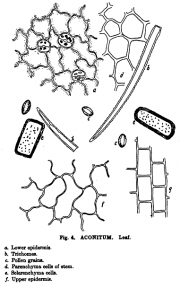Aconitum napellus (leaf)
(Update to use Microscopy template rather than old Botanical template.) |
|||
| Line 1: | Line 1: | ||
| + | =Introduction= | ||
| + | ''Introduction from Wikipedia, the free encyclopedia (http://en.wikipedia.org/wiki/Aconitum_napellus, retrieved 02/20/2012).'' | ||
| + | |||
| + | ''Aconitum napellus'' (Monkshood, "aconite", "Wolf's Bane", ''Fuzi'', "Monk's Blood", or "Monk's Hood") is a species of Aconitum in the family Ranunculaceae, native and endemic to western and central Europe. | ||
| + | |||
| + | It is a herbaceous perennial plant growing to 1 m tall, with hairless stems and leaves. The leaves are rounded, 5–10 cm diameter, palmately divided into five to seven deeply lobed segments. The flowers are dark purple to bluish-purple, narrow oblong helmet-shaped, 1–2 cm tall. | ||
| + | |||
| + | Plants are grown in gardens in temperate zones for their spike-like inflorescences that are showy in early-mid summer and their attractive foliage. There are white and rose colored forms in cultivation too. | ||
| + | |||
| + | ''The quoted text in this section was licensed for use under the Creative Commons ShareAlike License, version 3.0: http://creativecommons.org/licenses/by-sa/3.0/'' | ||
| + | =Macroscopic Entries= | ||
| + | =Microscopic Entries= | ||
| + | |||
{{Microscopy | source=Schneider, A. (1921) The Microanalysis of Powdered Vegetable Drugs, 2nd ed. | {{Microscopy | source=Schneider, A. (1921) The Microanalysis of Powdered Vegetable Drugs, 2nd ed. | ||
| mainimage=Microanalysis_powdered_vegetable_p_206_google_ver_aconitum.PNG | | mainimage=Microanalysis_powdered_vegetable_p_206_google_ver_aconitum.PNG | ||
| Line 9: | Line 22: | ||
| adulterants=Occasionally adulterated with the leaves of related species, and the leaves of Delphinium. | | adulterants=Occasionally adulterated with the leaves of related species, and the leaves of Delphinium. | ||
| }} | | }} | ||
| + | |||
| + | =HPTLC Entries= | ||
| + | =Other Points of Interest= | ||
Revision as of 20:46, 20 February 2012
Contents |
Introduction
Introduction from Wikipedia, the free encyclopedia (http://en.wikipedia.org/wiki/Aconitum_napellus, retrieved 02/20/2012).
Aconitum napellus (Monkshood, "aconite", "Wolf's Bane", Fuzi, "Monk's Blood", or "Monk's Hood") is a species of Aconitum in the family Ranunculaceae, native and endemic to western and central Europe.
It is a herbaceous perennial plant growing to 1 m tall, with hairless stems and leaves. The leaves are rounded, 5–10 cm diameter, palmately divided into five to seven deeply lobed segments. The flowers are dark purple to bluish-purple, narrow oblong helmet-shaped, 1–2 cm tall.
Plants are grown in gardens in temperate zones for their spike-like inflorescences that are showy in early-mid summer and their attractive foliage. There are white and rose colored forms in cultivation too.
The quoted text in this section was licensed for use under the Creative Commons ShareAlike License, version 3.0: http://creativecommons.org/licenses/by-sa/3.0/
Macroscopic Entries
Microscopic Entries
|
HPTLC Entries
Other Points of Interest
Cite error: <ref> tags exist, but no <references/> tag was found
